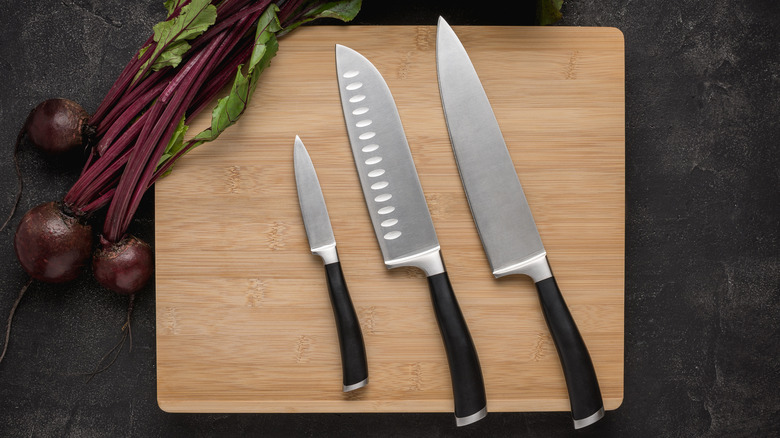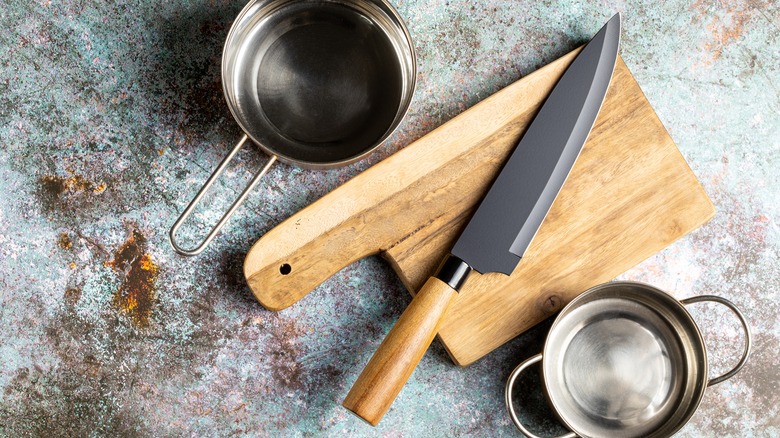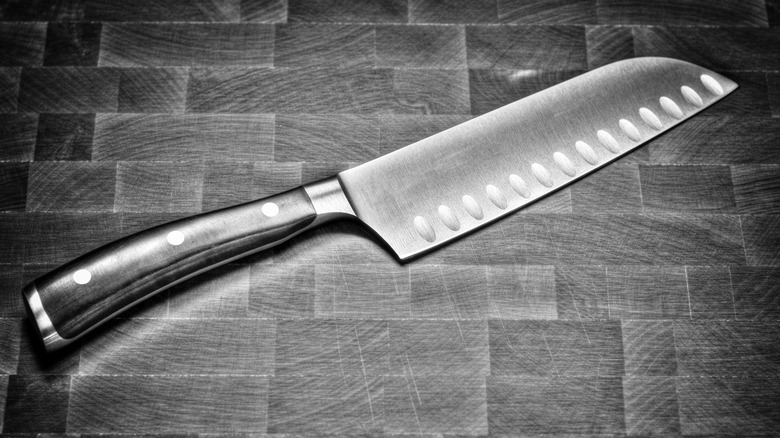The Precise Difference Between A Chef's Knife And A Santoku Knife
There is no tool more important in your kitchen than a good knife. Buying a great multi-purpose knife and keeping it well-sharpened is a must-do investment in your culinary success, but actually shopping for knives can be overwhelming, and you might even end up spending more for subpar tools you don't reach for. After all, doesn't it feel like those three knives in your ten-knife set that you've never used are silently judging you?
You've probably heard that there are a few crucial knives you need in your kitchen arsenal, and the one you've probably heard the most about is the chef's knife. This all-purpose knife is one of the most popular tools in various Western cuisines, but other cultures have their own versions of useful, reliable, versatile knives. For instance, have you ever heard of a Japanese santoku knife?
Both the chef's knife and the santoku knife are excellent multi-purpose knives that will get a lot of use in your home kitchen — way better than a big set of knives you might not even use. The main difference between them is their function: A chef's knife is long and heavy, designed for powerful chopping, while a santoku is smaller and lighter, designed to make thin, precise slices a breeze. Let's look at the similarities and differences between these knives so you can understand why each one is a valuable tool to keep in your kitchen.
The basic traits of a chef's knife
If properly maintained, a chef's knife will last you a lifetime. It's useful for practically any work you do in the kitchen, and can chop anything from thick slabs of meat to frozen vegetables. Chef's knives have long blades that curve towards a sharp tip, which can be used to separate pieces of meat or poultry or trim fat. Most models are relatively long, often sold at eight inches, and can be heavy to hold. A chef's knife will also usually be double-beveled, meaning it is sharpened on both sides.It will also commonly have a bolster, or a small piece of metal between the handle and blade, which a santoku knife lacks.
The curved shape of a chef's knife affects the way you use it. The curve will naturally rock the knife back and forth as you chop, so you want to keep the tip of the blade steady on your cutting board and follow that rocking motion. This will allow you to cut with more strength and less strain. Pressing down on heel of the knife (the base of the blade) will add extra pressure and allow you to chop through thick ingredients like melons or squash.
The special qualities of a santoku knife
One look at a santoku knife, and you might notice that it has a flat edge, not a curved one. They are usually shorter in length, and the blades are made from thin, durable steel. The width of the blade is useful for scraping ingredients off of a cutting board and into a hot pan. Because of its flat shape, a santoku doesn't lend itself to the "rocking" style of chopping. Instead, it is better used in simple up-and-down chopping style for best results.
The word santoku means "three virtues," which are generally understood to be chopping, dicing, and mincing. A santoku will traditionally be single beveled, which makes it easier to sharpen to a cutthroat edge, compared to a chef's knife. This is why the santoku is so good at creating extremely thin slices, and is great for working with more delicate proteins like fish. It can be used for a variety of tasks, but isn't ideal for heavy work like cutting meat, or dense vegetables like potatoes.
If you're looking to do elegant cuts with fragile ingredients, a santoku is your knife, but if you need a kitchen powerhouse, use a chef's knife. Make sure to assess different options (sizes, weights, etc.) to determine what feels the most comfortable for you. Either way, look for knives made of stainless steel labeled "high carbon," which is a great bet for sharpness and quality.



